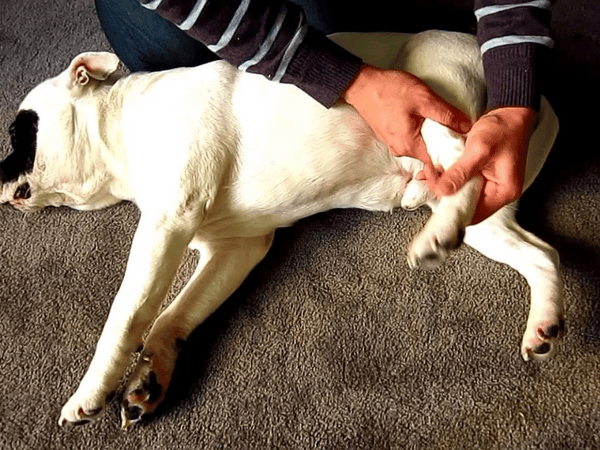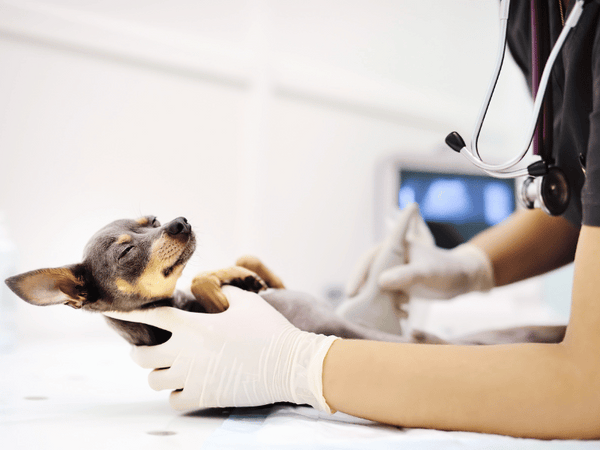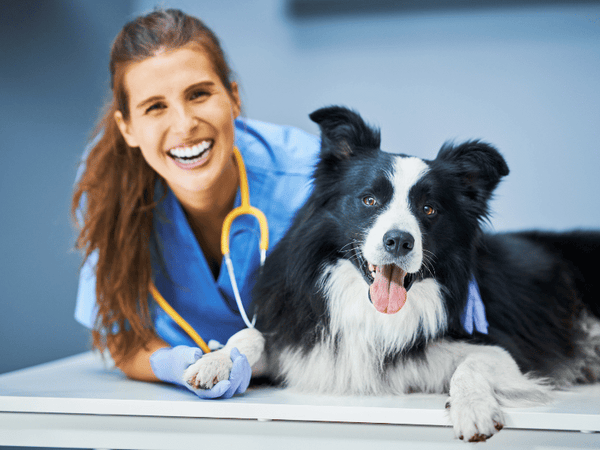Cushing's disease syndrome, a common endocrine disorder in dogs, can have profound effects on their overall health and well-being. While many dog owners are familiar with the typical symptoms such as increased thirst, appetite, and urination, fewer may be aware of its impact on their furry friend: Cushing's disease in dogs and mobility, particularly concerning their back legs. In this comprehensive guide, we delve into the intricate relationship between Cushing's disease syndrome and its effects on dogs' hind limbs.
As responsible pet owners, it's crucial to recognize the signs and symptoms of Cushing's disease in dogs and understand how it can manifest in various parts of the body, including the back legs. By gaining insight into this aspect of the condition, we can provide our canine companions with the care and support they need to maintain their quality of life.
Throughout this article, we'll explore the mechanisms by which Cushing's syndrome affects dogs' back legs, from muscle weakness and atrophy to lameness and mobility issues. We'll also discuss the importance of early detection, proper diagnosis, and effective treatment strategies to alleviate discomfort and improve mobility for dogs dealing with this challenging condition.
Join us as we embark on a journey to uncover the complexities of Cushing's disease in dogs and gain valuable insights into how we can better support our beloved pets, particularly in managing the effects on their back legs.
What is Cushing's Syndrome?

Cushing's syndrome, also known as hyperadrenocorticism, is a hormonal disorder that occurs when a dog's body produces too much cortisol, a steroid hormone typically released by the adrenal glands. This overproduction can be caused by various factors, including tumors in the pituitary gland or adrenal glands, as well as the prolonged administration of corticosteroid medications. Cushing's disease generally develops in senior dogs over the age of 6 but can develop in younger dogs.
There are two primary types of Cushing's disease in dogs: Pituitary Dependent Cushing's Syndrome and Adrenal Dependent Cushing's Syndrome. Pituitary Dependent Cushing's Syndrome occurs when a tumor develops in the pituitary gland, leading to an excess production of cortisol and an overstimulation of the adrenal glands. Adrenal Dependent Cushing's disease syndrome, on the other hand, occurs when a tumor develops directly in one or both of the adrenal glands, causing them to produce excessive cortisol independently of pituitary control.
Regardless of the underlying cause, the excessive levels of stress hormone cortisol circulating in the dog's body can wreak havoc on the dog's adrenal glands enlarged liver, and parent's body weight in various systems, leading to a dog suffering a wide range of symptoms from too much cortisol.
Urinary tract infections are common in most dogs with enlarged adrenal tumors and enlarged liver. These may include increased excessive thirst and urination, excessive hunger, weight gain, hair loss, thinning skin, and susceptibility to skin infections from too much cortisol.
While these symptoms are often the focus of Cushing's disease diagnosis and treatment of most dogs, it's essential not to overlook the impact of Cushing's disease in dogs, particularly the back legs. The hormonal imbalance caused by the condition can result in muscle weakness and atrophy in a dog's hind legs, as well as neurological signs of Cushing disease, such as lameness and mobility issues, which significantly affect a dog's quality of life.
By understanding these effects, pet owners can better support their dogs and work with veterinarians to develop comprehensive treatment plans tailored to their individual needs.
Alive Market CBD Oil For Pets
In recent years, pet owners have turned to alternative remedies like CBD oil to alleviate their furry companions' ailments. One such condition where CBD oil shows promise is the iatrogenic Cushing's Syndrome in dogs, particularly in addressing issues with their hind legs. Alive Market CBD Oil offers a natural solution that supports your pet with the iatrogenic Cushing's disease syndrome in diagnosing the iatrogenic Cushing's disease syndrome in dogs' mobility and overall well-being.
Cushing's Syndrome, a hormonal disorder often seen in older dogs, can lead to various symptoms, including weakness and stiffness in the back legs. This can severely impact your pet's quality of life, making it difficult for them to move around comfortably. However, the anti-inflammatory properties of CBD oil can help reduce inflammation and alleviate discomfort, providing much-needed relief for older dogs with Cushing's Syndrome.
Alive Market CBD Oil is specially formulated to meet the unique needs of pets, ensuring a safe and effective solution for managing their symptoms. By incorporating high-quality CBD extract into their formula, Alive Market aims to improve your pet's mobility and promote joint health. Whether your dog is struggling to stand up or experiencing difficulty walking, Alive Market CBD Oil offers a natural way to support their mobility and enhance their overall quality of life.
Additionally, Alive Market prioritizes transparency and quality, ensuring that their CBD oil undergoes rigorous testing to guarantee potency and purity. As a pet owner, you can trust that you're giving your furry friend the best possible care with Alive Market CBD Oil.
In conclusion, if you have a dog suffering from Cushing's Syndrome and experiencing issues with their hind legs, consider incorporating Alive Market CBD Oil into their daily routine. With its natural anti-inflammatory properties and commitment to quality, Alive Market CBD Oil can help your pet regain mobility and live a happier, healthier life.
How Cushing's Syndrome Affects Dogs' Back Legs
Muscle Weakness and Atrophy

Cushing's syndrome disrupts the delicate balance of hormones in a dog's body, leading to a cascade of physiological changes that can impact muscle function. One of the most noticeable effects is muscle weakness and atrophy in older dogs, particularly in the hind limbs.
The excessive levels of cortisol circulating in the dog's bloodstream can lead to protein breakdown and inhibit protein synthesis, resulting in muscle wasting and weakness. As a result, dogs with Cushing's syndrome may exhibit difficulty standing up, climbing stairs, or performing activities that require strength and coordination.
Moreover, the loss of muscle mass in the back of most dogs' hind legs can contribute to instability and imbalance, further impairing mobility and predisposing dogs to injuries. It's essential for pet owners to observe any signs of muscle wasting, weakness, or atrophy in their dogs' hind limbs and seek veterinary attention promptly to address these issues.
Lameness and Mobility Issues

In addition to muscle weakness and atrophy, dogs with Cushing's syndrome may experience lameness and mobility issues related to their back legs. The hormonal imbalance caused by the condition can affect joint health and function, leading to stiffness, pain, and difficulty moving.
Lameness, characterized by an abnormal gait or limping, may develop as a result of inflammation, joint degeneration, or soft tissue injuries exacerbated by Cushing's syndrome. Dogs may exhibit reluctance to bear weight on their affected limbs, favoring one side or exhibiting a stiff, awkward gait.
Mobility issues can significantly impact a dog's ability to engage in daily activities such as walking, running, and playing. It's essential for pet owners to monitor their dogs' mobility and seek veterinary evaluation if they notice any changes or abnormalities in their gait or movement patterns.
Risk of Secondary Conditions
Furthermore, the muscle weakness and mobility issues associated with Cushing's syndrome can increase a dog's susceptibility to secondary conditions affecting the back legs. Chronic inflammation, decreased immune function, and impaired healing mechanisms can predispose dogs to arthritis, joint instability, and soft tissue injuries.
Arthritis, in particular, may develop as a result of the chronic inflammation and joint degeneration associated with Cushing's syndrome. The gradual breakdown of cartilage and synovial fluid in the joints can lead to pain, stiffness, and reduced range of motion, further exacerbating mobility issues.
Additionally, dogs with Cushing's syndrome may be more prone to injuries such as skin infections and serious health problems such as ligament tears, muscle strains, and tendonitis due to their weakened musculoskeletal system. Pet owners suspect Cushing's disease, liver disease, or kidney disease often in dogs and should be vigilant in monitoring their dogs for signs of pain, swelling leg weakness, or lameness and consult with a veterinarian to address any underlying issues promptly.
Diagnosis of Cushing's Syndrome and Associated Back Leg Issues
Veterinary Examinations and Tests
Diagnosing Cushing's disease in dogs often requires a comprehensive veterinary evaluation, including a thorough physical examination and diagnostic testing. During the initial examination, the veterinarian will conduct a detailed assessment of the dog's overall health and specific symptoms, paying close attention to any clinical signs of muscle weakness, lameness leg weakness, or mobility issues affecting the back legs.
Diagnostic tests are then performed to confirm the presence of Cushing's syndrome and evaluate its effects on the dog's musculoskeletal system.
These tests may include:
Blood samples

These are collected to measure cortisol levels and assess other hormone levels, such as adrenocorticotropic hormone (ACTH Stimulation Test) and alkaline phosphatase (ALP). Elevated cortisol levels, particularly in the presence of concurrent clinical signs, may indicate Cushing's syndrome.
Urine Tests

Urine samples may be analyzed to measure cortisol levels or perform urine cortisol-to-creatinine ratio (UCCR) tests, which can help differentiate between pituitary-dependent and adrenal-dependent forms of Cushing's syndrome.
Imaging Studies

Radiographs (X-rays) or ultrasound scans may be recommended to evaluate the condition of the adrenal glands and detect any abnormalities, such as tumors or enlargement of enlarged adrenal glands. These imaging studies can also assess the degree of joint degeneration or soft tissue changes affecting the back legs.
Identifying Specific Symptoms
In addition to laboratory tests and imaging studies, veterinarians rely on the observation of specific symptoms to diagnose Cushing's syndrome and associated back leg issues in dogs. Key indicators for diagnosing Cushing's disease in dogs may include:
Muscle Weakness
Assessing the dog's hind legs' ability to stand, walk, and perform basic movements can provide valuable insights into the extent of muscle weakness and atrophy affecting the back of most dogs and dog's hind legs only.
Lameness and Gait Abnormalities
Observing the dog's gait, posture, and limb movements can help identify lameness, stiffness, or irregularities in their walking pattern indicative of musculoskeletal problems.
Pain and Discomfort
Dogs with Cushing's syndrome may exhibit signs of pain, discomfort, or reluctance to move, particularly when pressure is applied to the affected joints or muscles in the back legs.
It also causes muscular weakness, hair loss, weight gain, increased drinking and urination, and can leave dogs at a greater risk for other health conditions as well. Muscle weakness may cause the animal to gain a pot belly.
By combining the results of diagnostic tests with the clinical findings obtained during the veterinary examination, veterinarians can make an accurate diagnosis of Cushing's syndrome and assess its effects on the dog's back legs. This comprehensive approach enables them to develop tailored treatment plans to address the underlying hormonal imbalance and manage associated musculoskeletal issues effectively.
Treatment Options and Management Strategies
Once a diagnosis of Cushing's syndrome and associated back leg issues has been confirmed, veterinarians will work with pet owners to develop a comprehensive treatment plan aimed at alleviating symptoms, managing the underlying hormonal imbalance, and improving the dog's quality of life. Treatment options and management strategies may include:
Medications for Cushing's Syndrome
Adrenal Function Suppressants
Medications such as trilostane or mitotane may be prescribed to suppress the excessive production of cortisol by the dog's adrenal glands. These drugs help the adrenal gland release cortisol to restore hormonal balance and alleviate the symptoms associated with Cushing's syndrome, including muscle weakness and lameness.
Pituitary Hormone Modulators
Dopamine agonists such as pergolide or cabergoline may be used to reduce the secretion of adrenocorticotropic hormone (ACTH) by the pituitary gland, thereby decreasing the stimulation of the dog's adrenal glands and cortisol production.
Monitoring and Adjustment
Regular monitoring of cortisol levels and other clinical signs and symptoms is essential to assessing the effectiveness of medication and making necessary dosage adjustments. Veterinarians may perform follow-up tests and examinations to ensure optimal treatment outcomes.
Physical Therapy and Rehabilitation
Exercise Programs
Customized exercise routines incorporating targeted strengthening exercises, stretching, and range of motion exercises can help improve muscle tone and function in dogs with Cushing's syndrome and back leg issues. Low-impact activities, such as swimming or hydrotherapy, may also be beneficial.
Passive Range of Motion
Passive range-of-motion exercises involving gentle manipulation of the joints and limbs can help maintain flexibility and prevent stiffness in dogs with mobility issues. These exercises are often performed under the guidance of a veterinary rehabilitation therapist.
Dietary Considerations and Supplements
Balanced Nutrition
A balanced diet tailored to the individual dog's needs is essential for managing Cushing's syndrome and supporting the dog's adrenal gland and overall health and well-being. Veterinarians may recommend prescription diets formulated to support the dog's adrenal gland and glands and the adrenal gland to function and regulate stress hormone levels.
Joint Supplements
Supplements containing glucosamine, chondroitin, omega-3 fatty acids, and antioxidants can help support joint health and reduce inflammation in dogs with Cushing's syndrome and associated musculoskeletal issues. These supplements may help alleviate pain and improve mobility.
Lifestyle Adjustments
Environmental Modifications
Making modifications to the dog's living environment, such as providing ramps or steps to assist with mobility, placing nonslip mats on slippery surfaces, and ensuring comfortable bedding, can help minimize stress on the back legs and improve overall comfort.
Monitoring and Follow-Up Care
Regular monitoring of the dog's condition, including periodic veterinary check-ups and assessments of mobility and quality of life, is essential to detect any changes or complications early and adjust treatment accordingly.
By combining pharmacological interventions, physical therapy, dietary management, and lifestyle adjustments, pet owners can help improve the quality of both life expectancy and mobility for dogs with Cushing's syndrome and associated back leg issues.
Lifestyle Adjustments for Dogs with Cushing's Syndrome and Back Leg Issues
In addition to medical treatment and rehabilitation strategies, making appropriate lifestyle adjustments is crucial for ensuring the well-being and comfort of dogs with Cushing's syndrome and back leg issues. By creating a supportive environment and implementing practical measures to accommodate their needs, pet owners can enhance their dog's quality of life and minimize the impact of their condition on daily activities.
Here are some lifestyle adjustments to consider:
Providing a Supportive Environment

Comfortable Living Space
Create a comfortable and safe living environment for your dog, ensuring female dogs have access to soft bedding and cozy resting areas where they can relax and rest their back legs without discomfort.
Assistive Devices
Consider using assistive devices such as orthopedic beds, ramps, or stairs to help your dog navigate stairs, furniture, and other elevated surfaces with ease, reducing strain on their back legs.
Temperature Control
Maintain a comfortable temperature indoors, avoiding extreme heat or cold, which can exacerbate joint stiffness and discomfort in dogs with musculoskeletal issues.
Regular Monitoring and Follow-Up Care

Veterinary Check-Ups
Schedule regular veterinary check-ups to monitor your dog's condition, assess their mobility and joint health, and make any necessary adjustments to their treatment plan.
Physical Assessment
Conduct regular physical assessments at home to monitor changes in your dog's mobility, muscle strength, and overall well-being, noting any signs of discomfort or difficulty moving.
Medication Management
Ensure strict adherence to your dog's medication schedule, administering medications as prescribed by your veterinarian and reporting any adverse reactions or changes in their condition promptly.
Emotional Support and Mental Stimulation

Quality Time Together
Spend quality time with your dog, engaging in gentle activities such as grooming, massage, or cuddling to provide emotional support and strengthen your bond with your dog.
Mental Stimulation
Provide mental stimulation and enrichment activities to keep your dog's mind active and engaged, such as puzzle toys, interactive games, or training exercises tailored to their abilities.
Positive Reinforcement
Use positive reinforcement techniques to encourage and reward desired behaviors, reinforcing their confidence and sense of accomplishment despite their physical limitations.
By implementing these lifestyle adjustments and providing compassionate care and support, pet owners can help their dogs adapt to living with Cushing's syndrome and back leg issues, promoting their physical comfort, emotional well-being, and overall quality of life.
Preventive Measures and Tips for Dog Owners
While Cushing's syndrome and associated back leg issues can pose significant challenges for dogs and their owners, there are several preventive measures and tips that can help mitigate the risk of developing these conditions and manage their impact effectively.
By adopting proactive strategies and staying vigilant for signs of illness or discomfort, pet owners can promote their dog's health and well-being and minimize the progression of Cushing's syndrome and associated musculoskeletal issues.
Here are some preventive measures and tips for dog owners to consider:
Early Detection and Intervention
Recognize Symptoms
Familiarize yourself with the common signs and symptoms of Cushing's syndrome and associated back leg issues, such as increased thirst and urination, excessive panting, muscle weakness, lameness, and mobility issues.
Regular Veterinary Check-Ups
Schedule regular veterinary check-ups for your dog to monitor their overall health and detect any early signs of illness or abnormalities. Be proactive in discussing any concerns or changes in your dog's behavior or mobility with your veterinarian.
Promoting Overall Health and Well-Being
Balanced Diet
Provide a healthy dog with a balanced and nutritious diet tailored to your own dog's symptoms causing Cushing's syndrome and specific needs, ensuring a healthy dog has adequate protein, vitamins, and minerals to support their overall health and immune function. Consult with your veterinarian to select appropriate dietary options for dogs with Cushing's syndrome and musculoskeletal issues.
Regular Exercise
Encourage regular exercise and physical activity to maintain muscle strength, joint flexibility, and cardiovascular health in most dogs. Incorporate low-impact activities such as walking, swimming, or gentle play sessions into your dog's daily routine, avoiding excessive strain on their back legs.
Environmental Modifications
Safety Measures
Create a safe and secure environment for your dog, removing potential hazards and obstacles that could increase the risk of injury or exacerbate mobility issues. Use nonslip rugs or mats on slippery surfaces and provide stable footing on stairs and elevated areas.
Comfortable Accommodations
Provide comfortable bedding and resting areas for senior dog parents and your dog, ensuring younger dogs that they have adequate support for their back legs, and joints while sleeping or resting. Consider using orthopedic beds or cushions to relieve pressure and reduce discomfort for senior dogs.
Regular Monitoring and Awareness
Observation and Monitoring
Pay close attention to your dog's behavior, mobility, and overall well-being, monitoring for any changes or abnormalities that may indicate underlying serious health problems or issues. Keep a record of symptoms, changes in appetite, activity levels, and medication administration for reference during veterinary consultations.
Educate Yourself
Stay informed about Cushing's syndrome, musculoskeletal conditions, and general healthcare practices for dogs through reputable sources, veterinary publications, and professional guidance. Empower yourself with the knowledge to make informed decisions about your dog's health and well-being.
By implementing these preventive measures and tips, dog owners can take proactive steps to safeguard their pet's health and minimize the impact of Cushing's syndrome and associated back leg issues. Early detection, proactive management, and attentive care are essential for promoting the longevity, comfort, and quality of life of dogs affected by these conditions.
Conclusion
In conclusion, understanding the complexities of Cushing's syndrome and its effects on dogs' back legs is essential for providing optimal care and support to our beloved canine companions. This hormonal disorder can manifest in various ways, including muscle weakness, lameness, and mobility issues, which significantly impact the dog's quality of life.
Through diligent observation, regular veterinary check-ups, and proactive management strategies, pet owners can help mitigate the progression of Cushing's syndrome and associated musculoskeletal issues in their dogs. By implementing lifestyle adjustments, providing medical treatment, and promoting overall health and well-being, we can improve their comfort, mobility, and overall quality of life.
It's crucial for pet owners to remain vigilant for signs of illness or discomfort in their dogs and seek prompt veterinary attention when needed. By working closely with veterinarians and veterinary specialists, we can develop personalized treatment plans tailored to each dog's specific needs and optimize their long-term health and well-being.
As advocates for our furry friends, let's continue to prioritize their health and happiness, advocating for their well-being and ensuring they receive the care and support they deserve. Together, we can make a positive difference in the lives of dogs affected by Cushing's syndrome and musculoskeletal issues, enriching their lives and strengthening the bond between pets and their owners.
With dedication, compassion, and informed decision-making, we can navigate the challenges of managing Cushing's syndrome and associated back leg issues, empowering our dogs to live full, active, healthy, and fulfilling lives despite their health challenges. Let's continue to provide them with the love, care, and attention they need to thrive, now and in the years to come.
FAQs
1. What is Cushing's syndrome in dogs, and how does it affect their back legs?
Cushing's syndrome, or hyperadrenocorticism, is a hormonal disorder characterized by an overproduction of cortisol. This excess cortisol can lead to muscle weakness, atrophy, lameness, and mobility issues, particularly affecting the back legs of dogs.
2. What are the common symptoms of Cushing's syndrome in dogs that may affect their back legs?
Common symptoms of Cushing's syndrome in dogs include increased thirst and urination, excessive panting, weight gain, hair loss, thinning skin, muscle weakness, lameness, and difficulty standing or walking.
3. How is Cushing's syndrome diagnosed in dogs with back leg issues?
Diagnosis of Cushing's syndrome in dogs often involves a combination of veterinary examination, blood tests to measure cortisol levels, urine tests, and imaging studies such as radiographs or ultrasound scans to evaluate adrenal gland function and assess the extent of musculoskeletal issues.
4. What are the treatment options for dogs with Cushing's syndrome and associated back leg issues?
Treatment options may include medications to suppress cortisol production, physical therapy, and rehabilitation to improve muscle strength and mobility, dietary modifications, joint supplements, and lifestyle adjustments to support overall health and well-being.
5. Can Cushing's syndrome in dogs be cured, and will the back leg issues be resolved with treatment?
While Cushing's syndrome cannot be cured, it can be managed effectively with appropriate medical treatment and supportive care. With proper management, including medication, physical therapy, and lifestyle adjustments, the symptoms affecting the back legs may improve, leading to increased comfort and mobility for affected dogs.
6. Are there any preventive measures that dog owners can take to reduce the risk of Cushing's syndrome and back leg issues?
While some risk factors for Cushing's syndrome, such as age and breed predisposition, cannot be controlled, maintaining a healthy diet, regular exercise, and routine veterinary care can help promote overall health and reduce the risk of developing hormonal imbalances and musculoskeletal issues in dogs.
7. How can I support my dog's comfort and mobility if they have Cushing's syndrome and back leg issues?
Providing a supportive environment with comfortable bedding, implementing assistive devices such as ramps or stairs, engaging in regular exercise and physical therapy, and monitoring their condition closely for any changes or complications can help improve your dog's comfort and mobility despite their health challenges.
8. What is the life expectancy for a dog diagnosed with Cushing's Disease?
Statistically, dogs diagnosed with Cushing's Disease do experience a shorter lifespan. Because Cushing's syndrome lowers a dog's natural immunity, they are at a greater risk of developing other health conditions that can impact a dog's life span.


